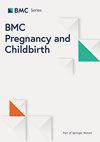在乌干达东部一家三级医院分娩的妇女中,妊娠晚期高血压前期与新生儿不良预后之间的关系:一项前瞻性队列研究
IF 2.8
2区 医学
Q1 OBSTETRICS & GYNECOLOGY
引用次数: 0
摘要
尽管最近的研究表明,妊娠期高血压与母亲和胎儿较高的发病率和死亡率有关,但目前现有的指南并未将妊娠期高血压视为高危妊娠状态。在非洲,尽管新生儿不良预后的发生率很高,但尚未对高血压前期进行研究。这项研究旨在确定金贾地区转诊医院妊娠晚期高血压前期妇女的新生儿不良预后与妊娠晚期高血压前期之间的关系。在2022年9月至2023年1月期间,进行了一项基于医院的前瞻性队列研究,其中包括300名孕妇。根据 JNC-8 标准,按照怀孕三个月的血压对参与者进行了划分。入院待产后,确定 150 名血压正常产妇和 150 名高血压前期产妇,并对其进行随访直至分娩,同时对其新生儿进行随访直至死亡或出院。使用相对危险度、X2 和曼特尔-海恩泽尔调整法对两组进行比较时,P 值≤ 0.05 是统计学意义的临界值。与正常血压妇女相比,高血压前期妇女的新生儿综合不良结局更常见(48.67% 对 32.67%),尤其是小妊娠年龄(SGA)、死胎和新生儿综合不良结局的可能性显著更高,相对风险率为 1.63(95% CI 1.10-2.42,p = 0.037)、9.0(95% CI 1.15-70.16,p = 0.010)和 1.55(95% CI 1.16-2.08,p < 0.001)。根据线性模型,收缩压每升高 10 mmHg,出生体重就会减少 45.1 g(p = 0.041,皮尔逊相关性为-0.118)。妊娠晚期的高血压前期会增加新生儿不良结局的风险,因此有必要降低妊娠高血压的临界值,可能的方法是采用 ACC/AHA 的孕妇血压定义。本文章由计算机程序翻译,如有差异,请以英文原文为准。
Association between late pregnancy prehypertension and adverse outcomes among newborns of women delivered at a tertiary hospital in Eastern Uganda: a prospective cohort study
Prehypertension during pregnancy is currently not considered as a high-risk pregnancy state in existing guidelines despite recent research correlating it with higher rates of morbidity and mortality in both the mother and the fetus. Studies on prehypertension have not been conducted in Africa despite high rates of poor neonatal outcomes. The study aimed to determine the association between late pregnancy prehypertension and adverse outcomes in newborns of women with late pregnancy prehypertension at Jinja Regional Referral Hospital. Between September 2022 and January 2023, a hospital-based prospective cohort study including 300 pregnant women was conducted. Participants were divided according to third-trimester blood pressure, as determined by the JNC-8 criteria. Following hospital admission for labor and delivery, 150 normotensive women and 150 prehypertensive women were identified and followed until delivery, and their neonates were followed until death or hospital discharge. A p value of ≤ 0.05 was the threshold for statistical significance when comparing the groups using the relative risk, X2, and Mantel-Haenszel adjustment. Composite adverse neonatal outcomes were more common in prehypertensive women compared to normotensive women (48.67% versus 32.67%), particularly Small-for-Gestation Age (SGA), stillbirth, and composite adverse neonatal outcomes had significantly higher likelihood, with aRRs of 1.63 (95% CI 1.10–2.42, p = 0.037), 9.0 (95% CI 1.15–70.16, p = 0.010), and 1.55 (95% CI 1.16–2.08, p < 0.001), respectively. By a linear model, birthweight decreased by 45.1 g for every 10 mmHg rise in systolic blood pressure (p = 0.041, Pearson correlation of -0.118). Prehypertension in late pregnancy increased risks for adverse neonatal outcomes, thus a need to potentially lower pregnancy hypertension cut-off levels possibly through adopting the ACC/AHA blood pressure definitions for pregnant women.
求助全文
通过发布文献求助,成功后即可免费获取论文全文。
去求助
来源期刊

BMC Pregnancy and Childbirth
OBSTETRICS & GYNECOLOGY-
CiteScore
4.90
自引率
6.50%
发文量
845
审稿时长
3-8 weeks
期刊介绍:
BMC Pregnancy & Childbirth is an open access, peer-reviewed journal that considers articles on all aspects of pregnancy and childbirth. The journal welcomes submissions on the biomedical aspects of pregnancy, breastfeeding, labor, maternal health, maternity care, trends and sociological aspects of pregnancy and childbirth.
 求助内容:
求助内容: 应助结果提醒方式:
应助结果提醒方式:


